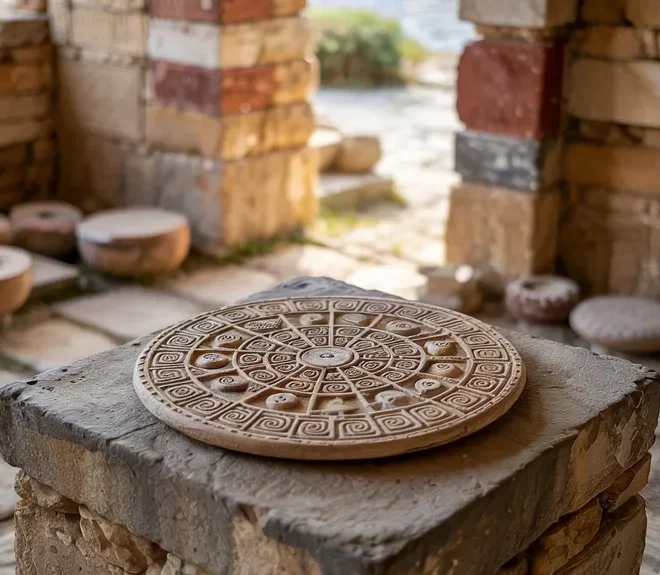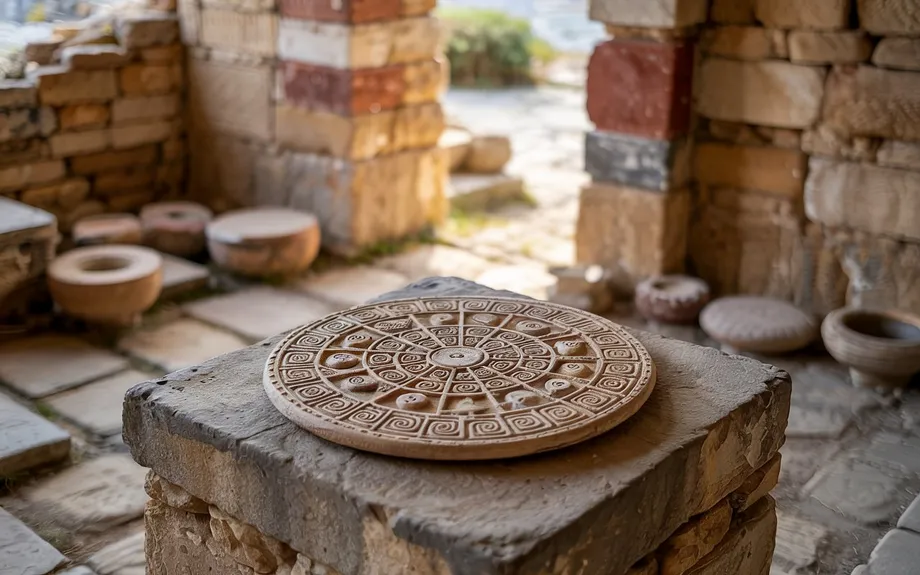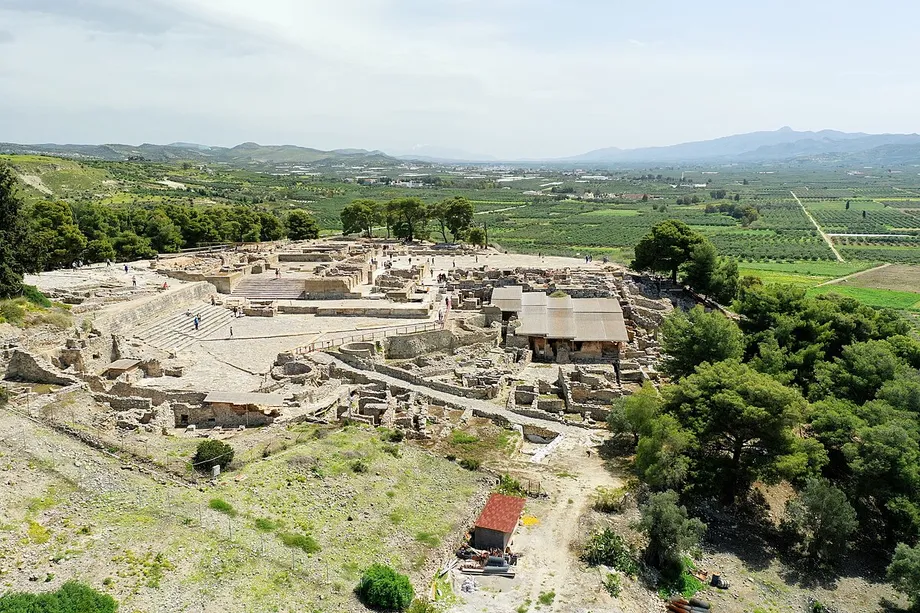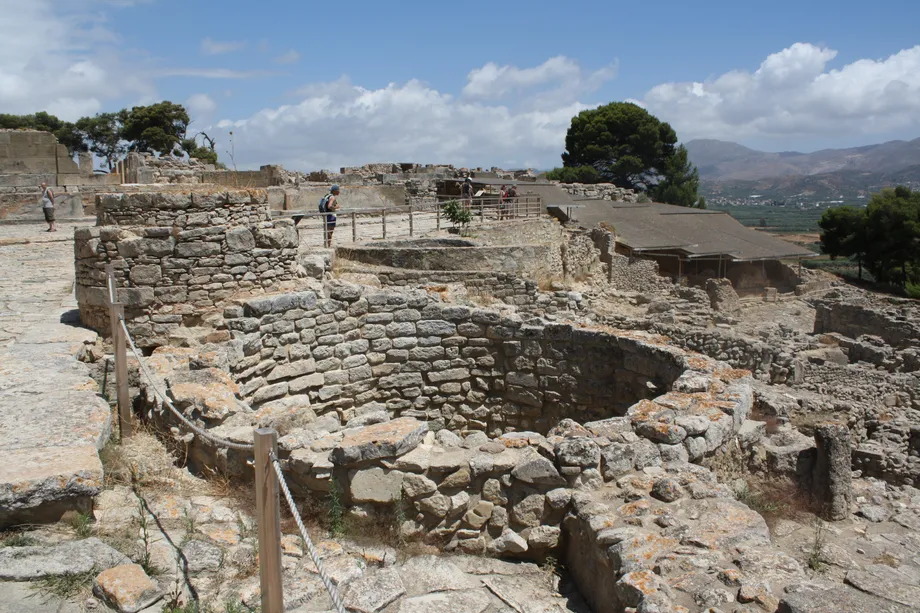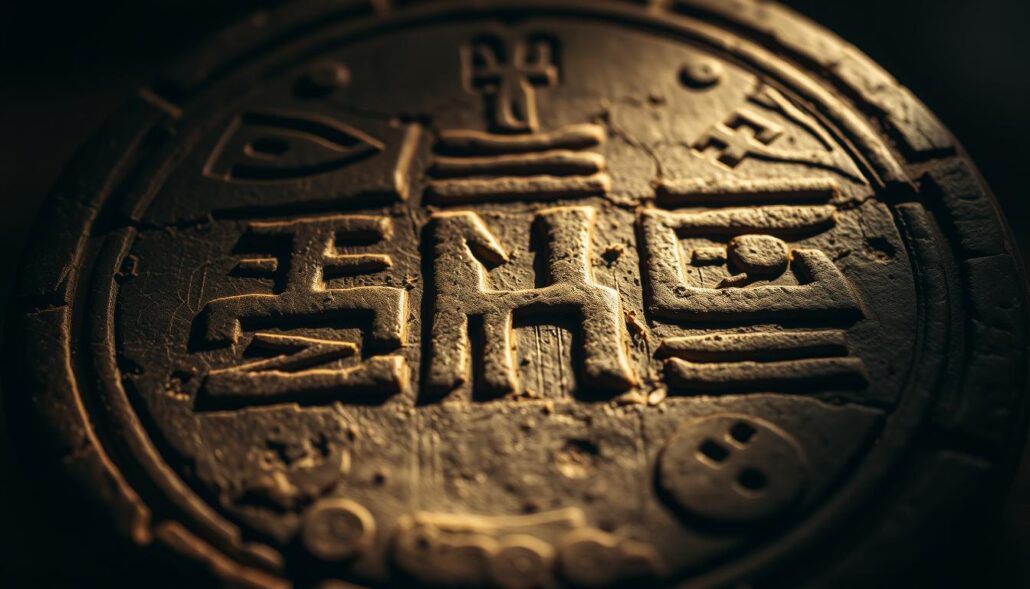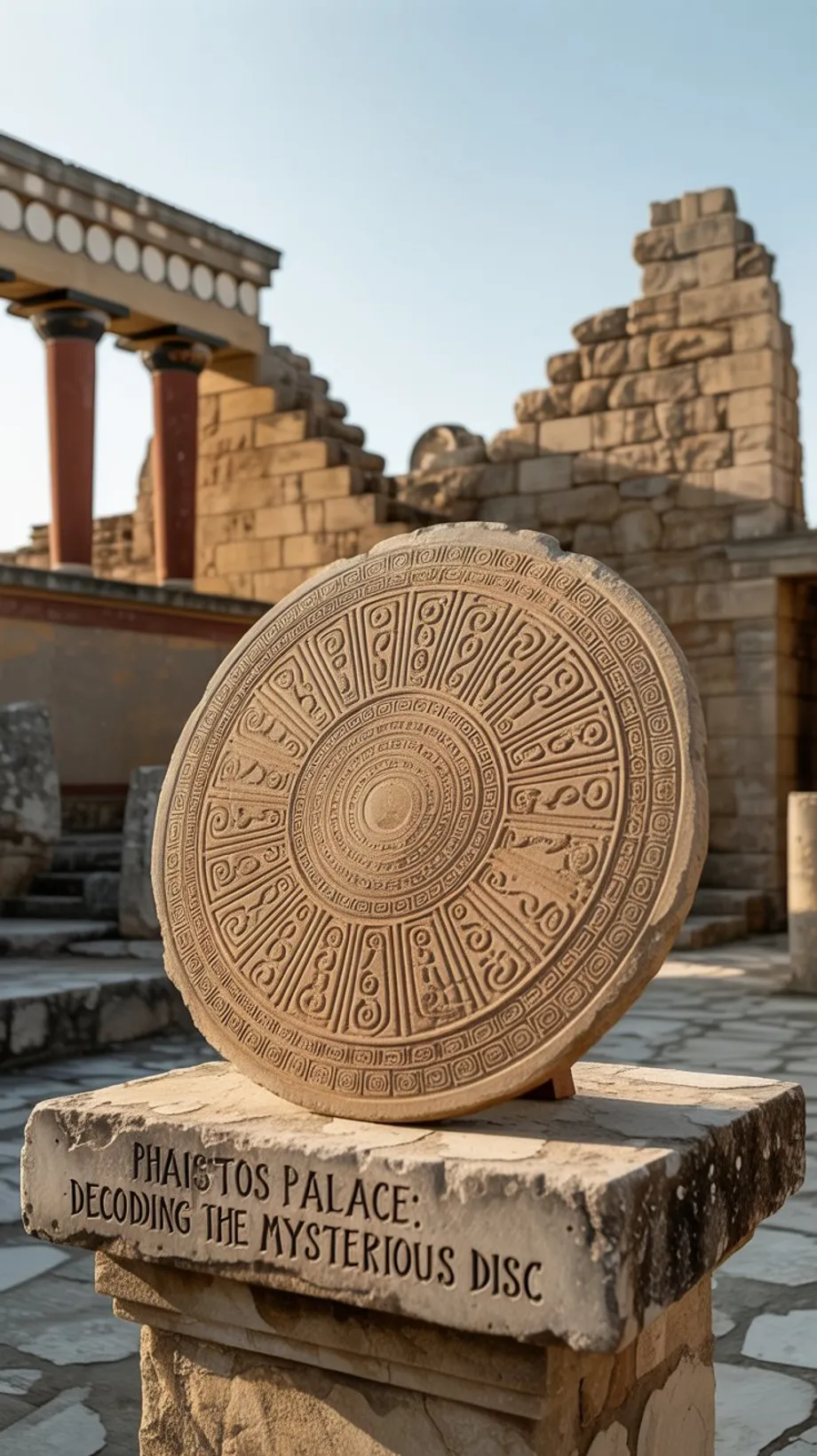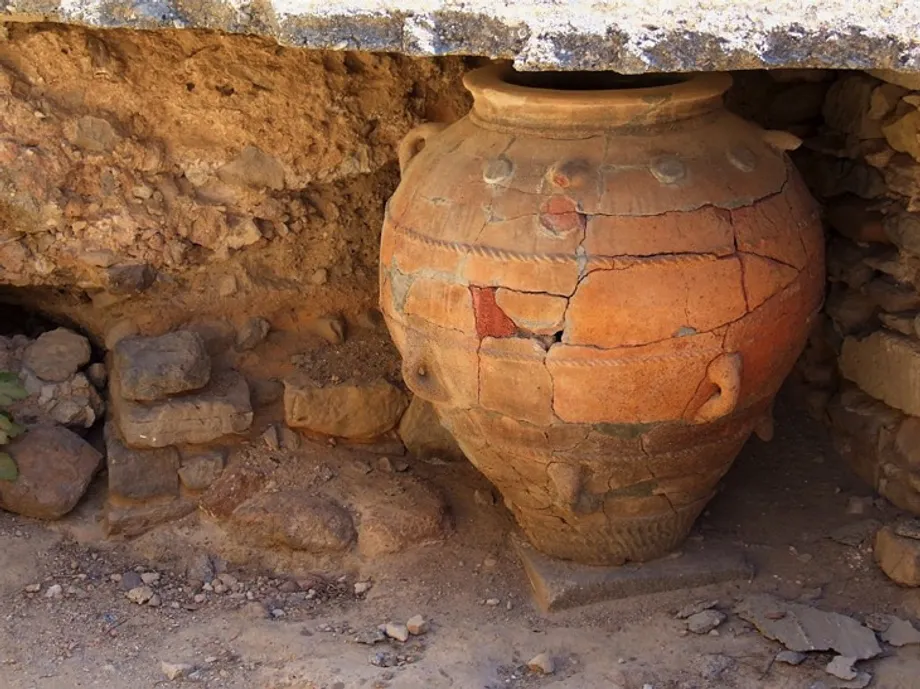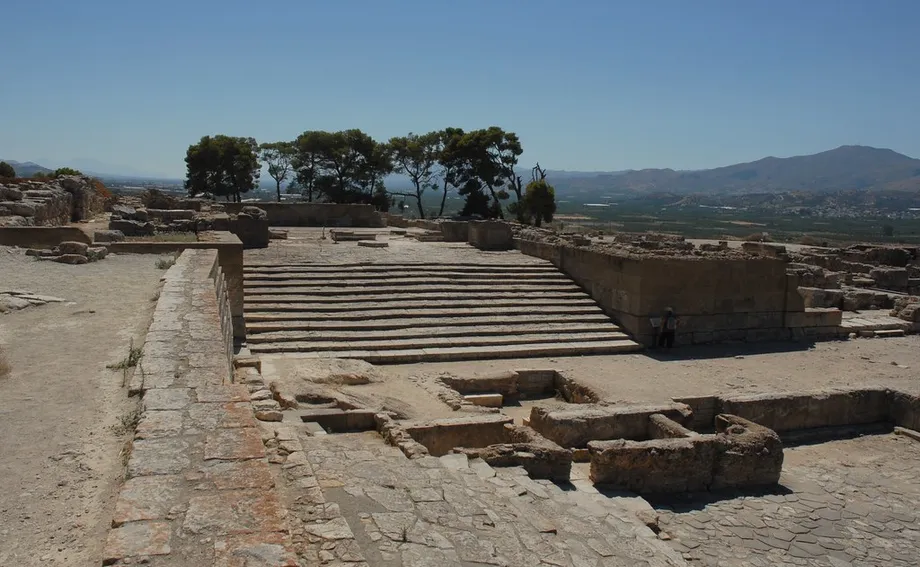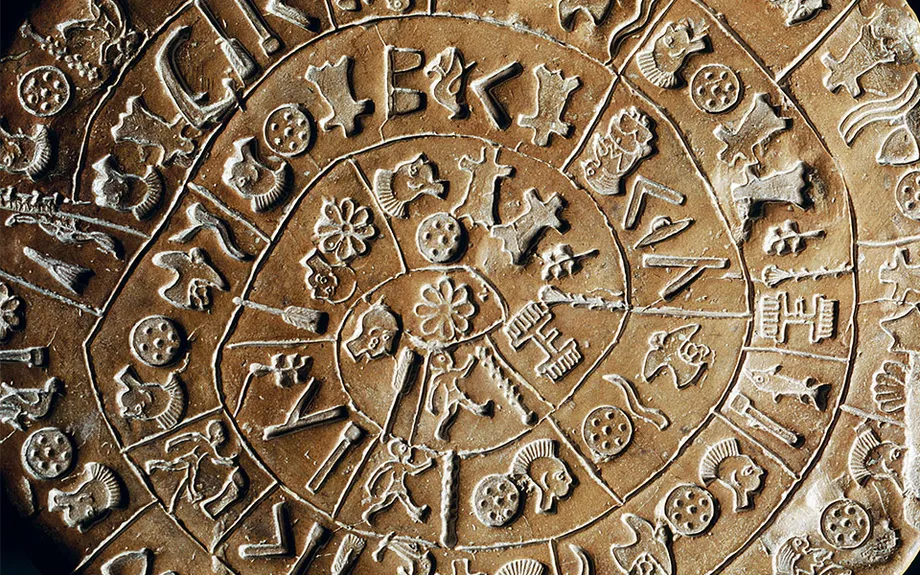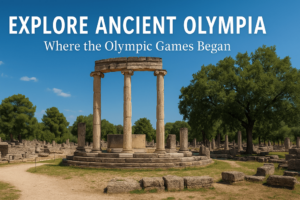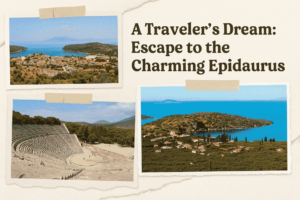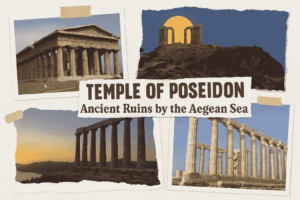Phaistos Palace: Decoding the Mysterious Disc
Imagine standing where ancient rulers once governed a thriving Bronze Age society. Beneath your feet lie weathered stones that witnessed rituals, trade, and perhaps even the creation of archaeology’s most perplexing puzzle. This isn’t just any archaeological site – it’s a gateway to understanding the sophisticated Minoan civilisation that flourished over 3,500 years ago.
Perched on Kastri Hill in south Crete, the ruins command sweeping views across the Messara Plain to Mount Ida. The complex spans 8,400 square metres – equivalent to nearly two football pitches – with the original city stretching kilometres into the valley below. Its strategic position, 5.6km from the Mediterranean coast, made it a hub for maritime trade and cultural exchange.
You’ll soon discover why this second-largest Minoan palace rivalled Knossos in influence. From Neolithic foundations to Bronze Age grandeur, layers of history reveal shifting power dynamics across the island. Yet the site’s true fascination lies in an artefact that’s baffled experts since 1908 – a fired clay disc stamped with undeciphered symbols.
What stories might these mysterious markings tell? As you explore further, you’ll unravel how this ancient centre blended myth, architecture, and innovation – leaving clues that still challenge our understanding of early Mediterranean societies.
Historical Background of Phaistos Palace
Long before Athens or Rome rose to prominence, a sophisticated society laid foundations that would puzzle historians for millennia. This ancient hub evolved through seismic cultural shifts, its story etched in clay tablets and bronze age architecture. Let’s peel back the layers of time to uncover how this centre weathered disasters and reinvented itself across eras.
Bronze Age Foundations and Early Beginnings
Your journey begins in 3600 BCE, when Neolithic farmers first settled these slopes. The first palace emerged around 2000 BCE during the Middle Minoan IB period, marking Crete’s leap into complex urban planning. Builders crafted storage magazines and ceremonial spaces using techniques that still impress modern engineers.
Three catastrophic events reshaped the site between 1900-1400 BCE. Each destruction phase – likely caused by earthquakes – sparked smarter reconstructions. The second palace era (1700 BCE) introduced light wells and drainage systems, showing how crises fuelled innovation.
Destructions, Reconstructions and Later Eras
After the final collapse around 1400 BCE, life continued in the shadow of former glory. By the 8th century BCE, the city regained prominence, minting silver staters as symbols of its economic power. You’d find bustling markets trading goods from across the Mediterranean during this Geometric Age revival.
The end came abruptly around 200 BCE. Rival city Gortyn razed the settlement, extinguishing three millennia of continuous habitation. Yet the stones still whisper tales of resilience – from bronze age artisans to Hellenistic merchants who called this place home.
Architectural Marvels and Intricate Layout
Picture yourself navigating staircases that once echoed with royal footsteps, your hands brushing against walls designed to withstand millennia. This Bronze Age masterpiece showcases engineering brilliance through its layered design, where every corridor whispers secrets of Minoan ingenuity.
Design Elements and Structural Features
You’ll marvel at how builders adapted to the hill’s natural contours, creating four stacked levels connected by cleverly angled staircases. The ground floor’s entrance system still impresses – a grand staircase funnelled visitors through ceremonial spaces before granting access to upper tiers.
Look for evidence of advanced plumbing in the ruins. Clay pipes and stone drains ran beneath polished floors, while light wells bathed rooms in sunshine. Even the walls served dual purposes, with pier-and-door partitions allowing flexible room configurations.
Theatre, Courtyards and Royal Apartments
Don’t miss the theatre’s eight-tiered seating – larger than its Knossos counterpart – where crowds gathered for sacred dances. Above this public space, the royal apartments reveal luxury through alabaster-lined walls and private balconies facing Mount Ida.
The colossal central courtyard anchors the complex. Measuring 55 metres long, its columned porticos hosted everything from grain storage audits to ritual bull-leaping. Here, the order of Minoan society unfolded beneath Cretan skies.
Deciphering the Enigma of the Phaistos Disc
Among the dust of millennia, a clay artefact emerged that would rewrite our understanding of ancient communication. This palm-sized relic, discovered during excavations led by Federico Halbherr‘s team, continues to spark fierce debates among scholars worldwide.
Archaeological Discoveries and Dating
Your journey into this mystery begins in 1908, when Italian archaeologist Luigi Pernier unearthed the disc in a basement chamber. Nestled among pottery fragments dating to 1800 BCE, its spiral of 45 unique characters offered no easy answers. The archaeological site yielded another clue – 61 Linear A inscriptions also found nearby, suggesting a culture comfortable with written records.
Analytical Theories and Interpretations
What secrets does this fired clay circle hold? Some researchers propose religious hymns, while others see naval inventories or astronomical charts. The disc‘s stamped characters reveal astonishing craftsmanship – each symbol pressed using reusable seals, like Bronze Age moveable type.
Despite countless attempts, no interpretation has earned universal acceptance. As you examine replicas today, you’re participating in a century-old quest to give name and meaning to humanity’s oldest printed text. The Phaistos Disc remains defiant – a silent challenge from our ancient past.
Minoan Civilisation and Cultural Legacy
Step into a world where spirituality shaped daily life, and every artefact tells stories of devotion. The Minoan civilisation thrived through intricate connections between sacred rites and community bonds, creating a legacy that still captivates historians today.
Religious Rituals and Social Life
In the southern wing of the complex, archaeologists uncovered a temple dedicated to Rhea – mother of Olympian gods. Here, initiates performed the ekdysia ceremony, a coming-of-age ritual involving symbolic rebirth. You can almost hear chants echoing through corridors where worshippers gathered for seasonal festivals.
Storage chambers reveal how these cities sustained their spiritual practices. Grape pips in clay jars hint at wine’s role in ceremonies, while towering pithoi stored sacred oils. Even everyday items like bridge-spouted bowls display divine motifs, blending utility with reverence.
The site’s layout mirrors Minoan priorities. Royal quarters sat alongside workshops producing ritual objects, showing how kings oversaw both governance and worship. Public theatres hosted performances honouring deities like Scotia Aphrodite, whose cult connected Crete to wider Mediterranean traditions.
Through clever land use, the complex controlled trade routes across fertile plains. Its strategic position made it a hub where faith, power, and commerce intertwined – a testament to the Minoan civilisation’s enduring influence.
Modern Excavations and Ongoing Research
Modern tools meet ancient mysteries at this Cretan landmark. Since Thomas Spratt first mapped the site in 1853 using naval charts, each generation of archaeologists has peeled back new layers of history.
From Trowels to Tech-Driven Discoveries
You’ll find Federico Halbherr and Luigi Pernier’s 1900-1904 digs revolutionary. Their team uncovered the first palace structures, setting standards for Mediterranean archaeological sites. Through careful stratigraphy, they dated finds to 1900-1700 BCE – a crucial period in Minoan history.
Post-war excavations transformed our understanding. Doro Levi’s 1950s work revealed earlier Neolithic ruins, while Fausto Longo’s 21st-century team uses 3D mapping to analyse erosion patterns. The Italian School’s ongoing project combines drone surveys with soil analysis, proving this site still guards secrets.
As you walk the archaeological sites, remember: each stone here represents centuries of international effort. From Pernier’s notebooks to laser scanners, the quest to decode this Minoan Palace Phaistos continues – one careful brushstroke at a time.

